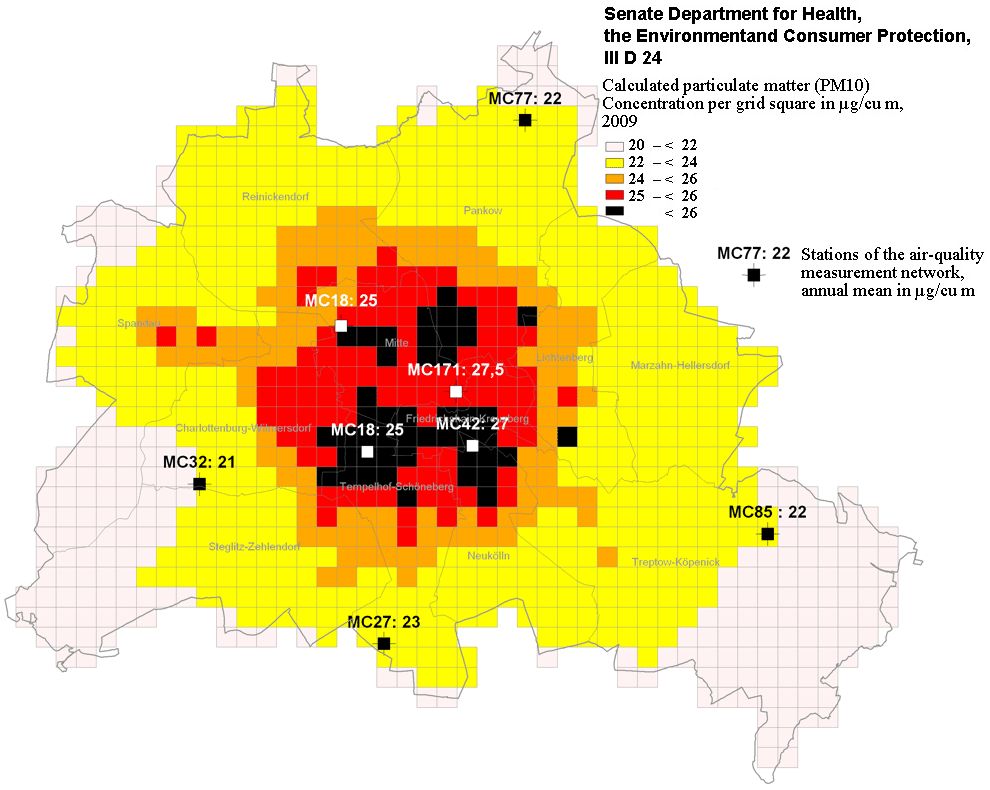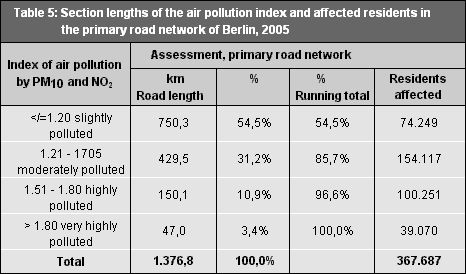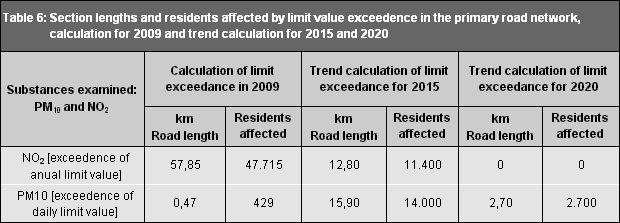Map 03.11.1 Auto Traffic Emissions, 2009
Generally, the transport-related emissions are primarily determined by the number and composition of the vehicle fleet, the lorry share, vehicle speed, the susceptibility of a particular road section to congestion, and the average specific emissions of the vehicles.
The primary roads have to cope with much of the traffic load in urban areas. Although the primary road network of Berlin shown on the map, with its length of approx. 1,380 km, accounts for only about 25 % of the total network of about 5,410 km, the major share of all mileage travelled, and of traffic-related emissions, occur on this segment of the network (in both cases over 80 % of the total).
While Table 4 contains the individual totals, the map shows the spatial distribution among the approx. 8,330 count sections.
All 945 sections with – in Berlin terms – “well above average” emissions of the pollutants NOx and PM10 have an “average daily traffic volume” (DTV) of more than 20,000, each with a lorry share of well above 10 %. Especially the heavier ones, those > 3.5 t, due to their powerful engines, account for a disproportionately large share of motor vehicle-related emissions (e.g. up to 75 % of soot particles).
Assignment to one of the four emissions classes does not allow direct conclusions to be drawn regarding the pollution/immissions situation in the respective section. For this purpose, separate calculations for concentrations of major substances are carried out, which take into account such necessary marginal factors as meteorology, as a non-constant quantum, and the particular route environment (see Methodology section). The calculation model provides an estimate of the concentration of pollutants within the street canyons, in areas in which people are likely to be present not only temporarily.
The sections of this evaluation level are predominantly such main roads as
- Parts of the city motorway A100
- Federal roads, such as Heerstraße or Potsdamer Straße
- Other important connecting routes, such as the routes Großer Stern – Kaiserdamm/Großer Stern – Martin-Luther-Straße, or the Leipziger Straße – Gruner Straße – Otto-Braun-Straße corridor.
Map 03.11.2 Index of air pollution for PM10 and NO2 in 2009
Measurements of the concentrations are only representative for a limited area around the measurement station, and particularly for the particulate PM10, strongly dependent on meteorological conditions.
These dependences are elucidated by the following depictions in Figures 10 to 13.
The trend of PM10 daily mean values in 2002, 2005, 2007 and 2010, at the measurement stations of the BLUME measurement network

![Fig. 10: 90.41 % value of particulate concentration PM10 [µg/cu.m.] in 2002 at the measurement stations of the BLUME measurement network](/imgscaler/8ER9F96sRXrVqALv-EWgM5HGVxkQsHVI7Bnrc6mC_uM/ropen/L3N5czExLXByb2QvdW13ZWx0YXRsYXMvX2Fzc2V0cy9sdWZ0L3N0cmFzc2VudmVya2Voci1lbWlzc2lvbmVuLXVuZC1pbW1pc3Npb25lbi9kcy1iL2VuLWFiYmlsZHVuZ2VuL21heHNpemVfMTJlYTkzZTJiMzdlYjZhZjFhN2VmZTRjOTlhZmE5NDRfZWFiMzExXzEwX2dyb3NzLmdpZg.jpg?ts=1678376738)
![Fig. 11: 90.41 % value of particulate concentration PM10 [µg/cu.m.] in 2005 at the measurement stations of the BLUME measurement network](/imgscaler/IbqNayyMaMLLfW1yI-umjM2u1Utay9g6Ef85RDQVllc/ropen/L3N5czExLXByb2QvdW13ZWx0YXRsYXMvX2Fzc2V0cy9sdWZ0L3N0cmFzc2VudmVya2Voci1lbWlzc2lvbmVuLXVuZC1pbW1pc3Npb25lbi9kcy1iL2VuLWFiYmlsZHVuZ2VuL21heHNpemVfZjk2NDliMTJiY2Q5MzY4NzhmODhhMGU1NzVkOWRjMmJfZWFiMzExXzExX2dyb3NzLmdpZg.jpg?ts=1678376726)
![Fig. 12: 90.41 % value of particulate concentration PM10 [µg/cu.m.] in 2007 at the measurement stations of the BLUME measurement network](/imgscaler/8uH1aUv8VXAu3PyTBlVYPeLzN9xKnzyK32qNLP7EDLA/ropen/L3N5czExLXByb2QvdW13ZWx0YXRsYXMvX2Fzc2V0cy9sdWZ0L3N0cmFzc2VudmVya2Voci1lbWlzc2lvbmVuLXVuZC1pbW1pc3Npb25lbi9kcy1iL2VuLWFiYmlsZHVuZ2VuL21heHNpemVfZGZjMzIyMGVjOTg5MjI3NWMwY2I3ODc3NmRlYmQzNzlfZWFiMzExXzEyX2dyb3NzLmdpZg.jpg?ts=1678376708)
![Fig. 13: 90.41 % value of particulate concentration PM10 [µg/cu.m.] in 2010 at the measurement stations of the BLUME measurement network](/imgscaler/4NzB6mE25AsXdgK9CgkHqXsfA34fzyN0a_lUOz-zwNU/ropen/L3N5czExLXByb2QvdW13ZWx0YXRsYXMvX2Fzc2V0cy9sdWZ0L3N0cmFzc2VudmVya2Voci1lbWlzc2lvbmVuLXVuZC1pbW1pc3Npb25lbi9kcy1iL2VuLWFiYmlsZHVuZ2VuL21heHNpemVfMzU5Nzc3ZTc3OTc5M2M5MmVmMzdlZjYyYmFhNjE5ZGRfZWFiMzExXzEzX2dyLmdpZg.jpg?ts=1678376697)


